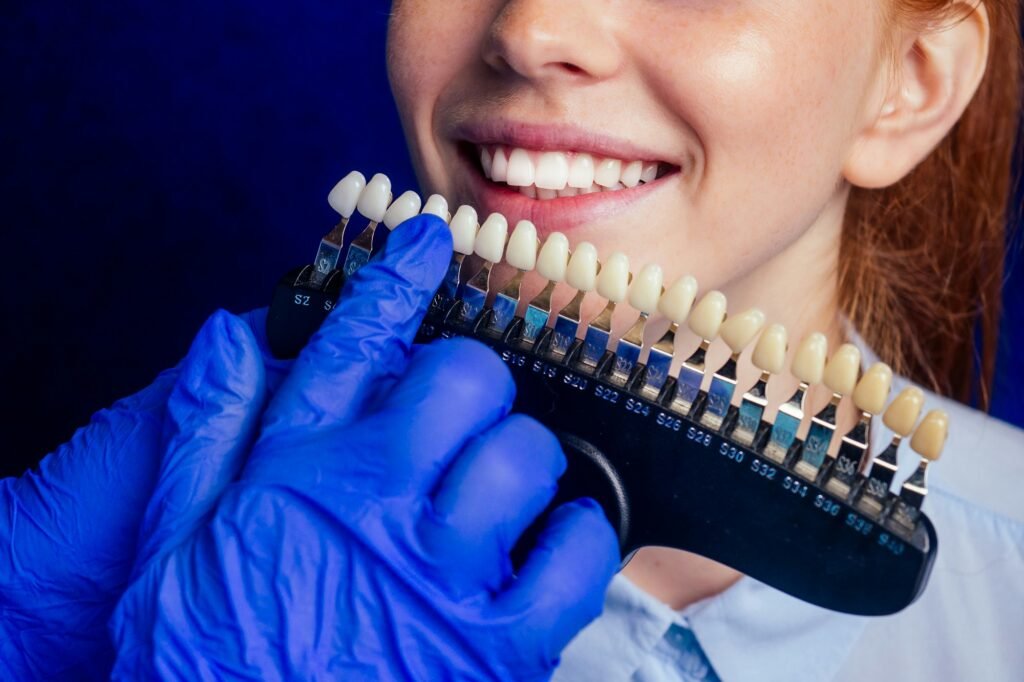Dental crowns are restorative coverings placed over damaged or decayed teeth to restore their shape, size, strength, and appearance. They are a common dental procedure used to protect teeth that are weakened, restore broken teeth, support dental bridges, cover dental implants, and improve the cosmetic appearance of teeth.
Types of Dental Crowns
- Metal Crowns:
- Materials: Gold, platinum, or base metal alloys (such as cobalt-chromium and nickel-chromium).
- Advantages: Very durable and withstand biting and chewing forces well.
- Disadvantages: Metallic color is a cosmetic concern.
- Porcelain-Fused-to-Metal (PFM) Crowns:
- Materials: Metal structure with a porcelain overlay.
- Advantages: Strong and aesthetically pleasing.
- Disadvantages: Can cause wear on opposing teeth and may show metal if gums recede.
- All-Ceramic or All-Porcelain Crowns:
- Materials: Pure ceramic or porcelain.
- Advantages: Best natural color match, suitable for people with metal allergies.
- Disadvantages: Less durable than metal or PFM crowns.
- Zirconia Crowns:
- Materials: Zirconium dioxide.
- Advantages: Extremely strong, durable, and aesthetically pleasing.
- Disadvantages: Can be more abrasive to opposing teeth.
- Resin Crowns:
- Materials: Composite resin.
- Advantages: Less expensive, minimal tooth removal.
- Disadvantages: Wear down over time, prone to fractures.
Indications for Dental Crowns
- To Protect Weak Teeth: Crowns protect teeth weakened by decay or large fillings from breaking.
- To Restore Broken Teeth: They can restore teeth that are already broken or severely worn down.
- To Cover and Support a Tooth with a Large Filling: When there is not much tooth left.
- To Hold a Dental Bridge in Place: Crowns can anchor a dental bridge.
- To Cover Misshaped or Severely Discolored Teeth: Improve cosmetic appearance.
- To Cover Dental Implants: Complete the restoration process.
- To Make a Cosmetic Modification: For aesthetic improvements.
Procedure for Getting a Dental Crown
- Initial Consultation and Examination:
- The dentist examines the tooth and takes X-rays.
- Discussion of treatment options and material choices.
- Tooth Preparation:
- The tooth is reshaped to accommodate the crown.
- An impression of the tooth is taken to create a model for the crown.
- A temporary crown is placed to protect the tooth while the permanent crown is made.
- Crown Fabrication:
- The impression is sent to a dental lab where the crown is custom-made.
- This process can take 2-3 weeks.
- Crown Placement:
- The temporary crown is removed.
- The permanent crown is checked for fit and color.
- The crown is cemented into place.
Benefits of Dental Crowns
- Restoration of Functionality: Restores normal function for biting and chewing.
- Aesthetic Improvement: Enhances the appearance of damaged or discolored teeth.
- Protection: Provides a protective cover for weakened teeth.
- Longevity: With proper care, dental crowns can last many years.
- Versatility: Can be used in various restorative and cosmetic procedures.
Aftercare for Dental Crowns
- Oral Hygiene: Maintain good oral hygiene practices, including brushing twice daily and flossing.
- Avoid Hard Foods: Avoid biting down on hard foods or objects to prevent damage to the crown.
- Regular Dental Checkups: Visit the dentist regularly for checkups and cleanings.
- Managing Sensitivity: Some sensitivity to hot or cold may occur; using a toothpaste for sensitive teeth can help.
Potential Complications
- Sensitivity: Newly crowned teeth may be sensitive immediately after the procedure.
- Crown Loosening: Cement can wash out, allowing the crown to become loose.
- Chipping: Porcelain crowns can sometimes chip.
- Discomfort or Bite Issues: If the crown is too high, it may cause discomfort.
Conclusion
Dental crowns are a versatile and effective solution for restoring damaged or aesthetically compromised teeth. With advancements in dental materials and techniques, patients can expect durable and natural-looking results. Proper care and regular dental visits ensure the longevity and success of dental crowns, contributing to overall oral health and improved quality of life.


